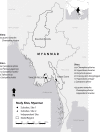Detection of novel coronaviruses in bats in Myanmar
- PMID: 32271768
- PMCID: PMC7144984
- DOI: 10.1371/journal.pone.0230802
Detection of novel coronaviruses in bats in Myanmar
Erratum in
-
Correction: Detection of novel coronaviruses in bats in Myanmar.PLoS One. 2023 Dec 4;18(12):e0295490. doi: 10.1371/journal.pone.0295490. eCollection 2023. PLoS One. 2023. PMID: 38048309 Free PMC article.
Abstract
The recent emergence of bat-borne zoonotic viruses warrants vigilant surveillance in their natural hosts. Of particular concern is the family of coronaviruses, which includes the causative agents of severe acute respiratory syndrome (SARS), Middle East respiratory syndrome (MERS), and most recently, Coronavirus Disease 2019 (COVID-19), an epidemic of acute respiratory illness originating from Wuhan, China in December 2019. Viral detection, discovery, and surveillance activities were undertaken in Myanmar to identify viruses in animals at high risk contact interfaces with people. Free-ranging bats were captured, and rectal and oral swabs and guano samples collected for coronaviral screening using broadly reactive consensus conventional polymerase chain reaction. Sequences from positives were compared to known coronaviruses. Three novel alphacoronaviruses, three novel betacoronaviruses, and one known alphacoronavirus previously identified in other southeast Asian countries were detected for the first time in bats in Myanmar. Ongoing land use change remains a prominent driver of zoonotic disease emergence in Myanmar, bringing humans into ever closer contact with wildlife, and justifying continued surveillance and vigilance at broad scales.
Conflict of interest statement
The authors have declared that no competing interests exist.
Figures
References
MeSH terms
LinkOut - more resources
Full Text Sources
Miscellaneous


